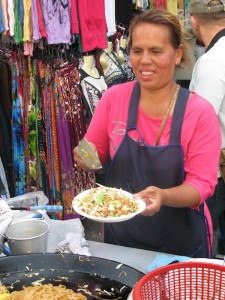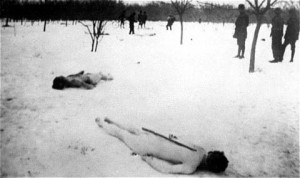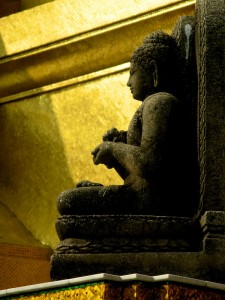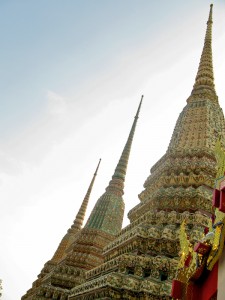Dacă aţi căutat-o zilele astea pe Cristina Bazavan la vechea adresă, să ştiţi că s-a mutat. Încercaţi mai bine la http://bazavan.ro/. Acolo răspunde sigur. Dacă întârzie, nu i-o luaţi în nume de rău. Ultima dată când am căutat-o îi scria o scrisoare lui Anton Pavlovici Cehov, s-o fi luat cu asta şi aude mai greu soneria. Dar de răspuns, răspunde sigur. Şi e o vizită care nu trebuie ratată.
Mumia de partid şi de stat
Rusia îşi pune din nou problema îngropării rămăşiţelor lui Lenin, păstrate din 1924 şi până astăzi sub formă de mumie în cadrul mausoleului din Piaţa Roşie.
Deşi au trecut 87 de ani de la moartea ideologului bolşevic, fostul preşedinte Mihail Gorbaciov consideră încă prematură îngroparea sa:
Cred că vom ajunge aici, dar consider că, pentru moment, nu trebuie să luam măsuri pentru a-l îngropa.
Dincolo de prostul gust absolut al mumificării lui Lenin, gestul politic în sine e pur şi simplu ridicol. E incredibil că un regim profund ateist a putut să aleagă o formă de legitimare simbolică cu rădăcini directe în hagiografia creştină. Venerarea moaştelor, un obicei pe cât de necreştinesc, pe atât de îndrăgit de bisericile răsăritene, porneşte de la mai multe legende legate de mumificarea naturală a cadavrelor sfinţilor, care ar fi fost descoperite peste zeci şi chiar sute de ani în stare aproape intactă.
Lipsit de o istorie la fel de lungă ca a creştinismului, care să-i permită întreţinerea unor astfel de naraţiuni fondatoare, comunismul sovietic şi-a îmbălsămat singur înainte-mergătorul, dovedind astfel superioritatea necrofiliei ştiinţifice, de partid şi de stat, asupra necrofiliei obscurantiste, religioase şi populare. Ei, bravos!
70 ani de la pogromul de la Bucureşti
Pe 21 ianuarie 1941, legionarii refuză să accepte demiterea de către generalul Antonescu a ministrului de interne, a directorului general al poliţiilor şi a unui alt director din Ministerul de Interne, toţi oameni ai Legiunii, şi se baricadează înarmaţi în localul Siguranţei, în sediul Prefecturii Poliţiei Capitalei, în sediul lor central din str. Roma şi în Cazarma gardienilor publici. Ei cer demiterea lui Antonescu şi crearea unui guvern legionar “pur” care să ducă mai departe procesul de “românizare” (un alt punct al discordiei între şeful guvernului şi legionari fusese desfiinţarea, cu câteva zile în urmă, a “comisarilor de românizare” din întreprinderi, pe care Antonescu îi considera “o idee excepţională” pusă în practică “în mod dezastruos”). În mai puţin de o zi, rebeliunea legionară este generalizată în toată ţara.
Pe 22 ianuarie, Hitler îl asigură pe Antonescu de sprijinul său şi dă ordin trupelor germane staţionate pe teritoriul României să stea la dispoziţia generalului. În seara aceleiaşi zile, armata română lichidează rebeliunea. În timpul conflictului îşi pierd viaţa 21 de ofiţeri, subofiţeri şi soldaţi, iar alţi 53 de militari sunt răniţi. În întreaga ţară, rebelii au asasinat 374 de persoane şi au rănit alte 380.
La Bucureşti, în timpul celor două zile de insurgenţă, legionarii au ucis 120 de evrei. Mult mai mulţi au fost torturaţi, bătuţi sau jefuiţi:
Bătaia e ruptă din alocaţie
Am auzit azi dimineaţă la radio că Guvernul a hotărât să nu mai plătească alocaţia de creştere a copilului în cazurile în care copilul are nota scăzută la purtare. Nu mă pot opri să nu mă gândesc ce consecinţe dramatice va avea această decizie în domeniul violenţei domestice. Dar, desigur, câteva mii de copii învineţiţi de părinţii lor alcoolici care nu vor mai avea în contul cui să mai bea pe datorie sunt un sacrificiu minor în comparaţie cu rezultatele spectaculose pe care această strategie revoluţionară de redresare bugetară le va produce. Hip, hip, ura!
Code sample – Path finder
/** * File: pathfinder.cpp * -------------------- * Path finder algorithm implemented * as part of the "Programming abstractions" * class (CS 106B) taken at Stanford. * Please note that only the main class was written entirely by me, * some of the other classes and interfaces were provided * as part of the assignment. * The final program also includes a library of classes, * which was provided as part of the assignment * and which I did not include here. */
#include <cmath> #include <fstream> #include <iostream> #include <string> #include "console.h" #include "pathfinder-graph.h" #include "pathfinder-graphics.h" #include "error.h" #include "gwindow.h" #include "map.h" #include "pqueue.h" #include "point.h" #include "tokenscanner.h" #include "set.h" #include "simpio.h" #include "strlib.h" #include <vector.h> #include "stdlib.h" // for atof #include "path.h" using namespace std;
static void giveInstructions(); static void newMap(PathfinderGraph& g); void readGraphFromFile(ifstream& infile, PathfinderGraph& g);
static void Dijkstra(PathfinderGraph& g); static void Dijkstra(const GPoint& pt, PathfinderGraph& g); void findShortestPath(Node* origin, const Node* destination, PathfinderGraph& g); double getPathCost(const Vector<Arc *>& path);
static void quitAction(); void drawGraph(PathfinderGraph& g); void printGraph(PathfinderGraph& g);
static const string kStarter_Map = "data-files/USA.txt"; static const int kClick_Tolerance = 5;
string getFileName(ifstream & infile, const string prompt);
/**
* Function: main
* --------------
* Defines the entry point for the entire application.
*/
int main() {
GWindow gw(kWindowWidth, kWindowHeight + kControlStripHeight);
initPathfinderGraphics(gw);
giveInstructions();
PathfinderGraph g;
ifstream infile;
infile.open(kStarter_Map.c_str());
readGraphFromFile(infile, g);
drawPathfinderMap(g.getMapFile());
drawGraph(g);
addButton("Quit", quitAction);
addButton("Map", newMap, g);
addButton("Dijkstra", Dijkstra, g);
pathfinderEventLoop();
return 0;
}
/**
* Function: giveInstructions
* Usage: giveInstructions();
* --------------------------
* Describes the Pathfinder assignment on the console. This text has
* been retained in its original form to preserve the assignment history.
*/
static void giveInstructions() {
cout << "This masterful piece of work is a graph extravaganza!" << endl;
cout << "The main attractions include a lovely visual presentation" << endl;
cout << "of the graph along with an implementation of Dijkstra's" << endl;
cout << "shortest path algorithm and Kruskal's computation of" << endl;
cout << "a minimal spanning tree. Enjoy!" << endl << endl;
}
/** * newMap */
static void newMap(PathfinderGraph& g) {
g.clear();
ifstream infile;
string filename = getFileName(infile, "Please enter name of graph data file: ");
readGraphFromFile(infile, g);
drawPathfinderMap(g.getMapFile());
drawGraph(g);
printGraph(g);
}
/** * This function assumes that the data file is well formed. */
void readGraphFromFile(ifstream& infile, PathfinderGraph& g) {
string mapName;
getline(infile, mapName);
//cout << "Map name: " << mapName << endl;
g.setMapFile(mapName);
string newLine;
getline(infile, newLine); // get 'NODES"
//cout << newLine << endl;
getline(infile, newLine); // get first node
while (newLine != "ARCS") {
TokenScanner ts(newLine);
ts.ignoreWhitespace();
ts.scanNumbers();
Node *newNode = new Node;
newNode->name = ts.nextToken();
GPoint loc = GPoint(stringToInteger(ts.nextToken()), stringToInteger(ts.nextToken()));
newNode->loc = loc;
g.addNode(newNode);
//cout << newNode->name << loc.getX() << "; " << loc.getY() << endl;
getline(infile, newLine);
}
//cout << newLine << endl;
getline(infile, newLine); // get first arc
while (!infile.eof()) {
TokenScanner ts(newLine);
ts.ignoreWhitespace();
ts.scanNumbers();
Arc *newArc = new Arc;
Arc *mirrorArc = new Arc;
mirrorArc->finish = newArc->start = g.getNode(ts.nextToken());
mirrorArc->start = newArc->finish = g.getNode(ts.nextToken());
mirrorArc->cost = newArc->cost = atof(ts.nextToken().c_str());
g.addArc(newArc);
g.addArc(mirrorArc);
//cout << newArc->start->name << " " << newArc->finish->name << " " << newArc->cost << endl;
//cout << mirrorArc->start->name << " " << mirrorArc->finish->name << " " << mirrorArc->cost << endl;
getline(infile, newLine);
}
}
static void Dijkstra(PathfinderGraph& g) {
cout << "Please click on the origin and destination cities to find the cheapest path between them." << endl;
defineClickListener(Dijkstra, g);
}
static void Dijkstra(const GPoint& pt, PathfinderGraph& g) {
int x = pt.getX();
int y = pt.getY();
for (Node* node : g.getNodeSet()) {
if ( ((node->loc.getX() - kClick_Tolerance ) < x)
&& (x < (node->loc.getX() + kClick_Tolerance ))
&& ((node->loc.getY() - kClick_Tolerance ) < y)
&& (y < (node->loc.getY() + kClick_Tolerance )) ) {
if (g.getHighlightedNode() == NULL) {
drawGraph(g);
cout << "x: " << x << " y: " << y << endl;
cout << "Your chosen origin is " << node->name << "." << endl;
g.setHighlightedNode(node);
drawPathfinderNode(node->loc, kHighlightColor);
}
else {
Node* origin = g.getHighlightedNode();
cout << "Your chosen destination is " << node->name << "." << endl << endl;
g.setHighlightedNode(NULL);
drawPathfinderNode(node->loc, kHighlightColor);
findShortestPath(origin, node, g);
}
break;
}
}
}
void findShortestPath(Node* origin, const Node* destination, PathfinderGraph& g) {
cout << "Finding the cheapest path between " << origin->name << " and " << destination->name << "..." << endl;
Path* path = new Path;
PQueue<Path *> queue;
Node* start = origin;
Map<string, double> fixed;
while (start != destination) {
if (!fixed.containsKey(start->name)) {
fixed.put(start->name, path->getCost());
cout << "Fix the cost to " << start->name << " at " << path->getCost() << endl;
cout << "Process the arcs out of " << start->name << " (";
int arcs = 0;
for (Arc *arc : start->arcs) {
cout << arc->finish->name;
if (++arcs < start->arcs.size()) cout << ", ";
}
cout << ")" << endl;
for (Arc *arc : start->arcs) {
if (!fixed.containsKey(arc->finish->name)) {
path->addArc(arc);
queue.enqueue(path, path->getCost());
//cout << " " << "Enqueue the path: " << arc->start->name << " -> "
// << arc->finish->name << "(" << arc->cost << ")" << endl;
path->removeLast();
}
else cout << "Ignore " << arc->finish->name << " because its cost is known." << endl;
}
}
else cout << "Ignore " << origin->name << " because its cost is known." << endl;
if (queue.isEmpty()) {
path->clear();
break;
}
path = queue.extractMin();
//cout << "Dequeue the cheapest path: " << path.toString() << " (" << path.getCost() << ")." << endl;
start = path->getLast()->finish;
}
if (path->isEmpty())
cout << endl << "This is too daunting a task for a modest computer like me. "
<< "Please stop tormenting me and choose two distinct cities." << endl << endl;
else {
cout << endl << "The cheapest path between " << origin->name << " and " << destination->name
<< " is: " << path->toString() << "." << endl << endl;
}
}
double getPathCost(const Vector<Arc *>& path) {
double cost = 0;
for (Arc *arc : path) {
cost += arc->cost;
}
return cost;
}
/**
* Function: quitAction
* Usage: quitAction(g);
* ---------------------
* Called when the user clicks the Quit button in the control strip.
*/
static void quitAction() {
exitGraphics();
}
/**
* Gets a new map file name from the user and opens the file.
* If the file does not exist, it prompts the user for another file name.
* Same if the file cannot be opened.
* Returns the file name.
*/
string getFileName(ifstream & infile, const string prompt) {
while (true) {
cout << prompt;
string filename;
cin >> filename;
filename = string("data-files/") + filename;
infile.open(filename.c_str());
if(!infile.fail()) return filename;
infile.clear();
cout << "Unable to open the map file named " << filename << ". It may be missing or corrupted. Please select another file." << endl;
}
}
/**
* Function: drawGraph
* Usage: drawGraph(g);
* -------------------
* Draws all the nodes and all the arcs of the graph.
*/
void drawGraph(PathfinderGraph& g) {
for (Node* node : g.getNodeSet()) {
drawPathfinderNode(node->loc, kNodeColor, node->name);
}
for (Arc* arc : g.getArcSet()) {
drawPathfinderArc(arc->start->loc, arc->finish->loc, kArcColor);
}
}
/**
* Helper Function: printGraph
* Usage: printGraph(g);
* ---------------------------
* Prints all nodes and all arcs of the graph to the console.
*/
void printGraph(PathfinderGraph& g) {
cout << endl << "PRINTING GRAPH: " << endl;
cout << g.getMapFile() << endl;
cout << "NODES" << endl;
for (Node* node : g.getNodeSet()) {
cout << node->name << " " << node->loc.getX() << " " << node->loc.getY() << endl;
}
cout << "ARCS " << endl;
for (Arc* arc : g.getArcSet()) {
cout << arc->start->name << " " << arc->finish->name << " " << arc->cost << endl;
}
}
/*
* File: graphtypes.h * ------------------ * This file defines low-level data structures that represent graphs. */
#ifndef _graphtypes_h #define _graphtypes_h
#include <string> #include "gtypes.h" #include "map.h" #include "set.h"
struct Node; /* Forward references to these two types so */ struct Arc; /* that the C++ compiler can recognize them. */
/* * Type: SimpleGraph * ----------------- * This type represents a graph and consists of a set of nodes, a set of * arcs, and a map that creates an association between names and nodes. */
struct SimpleGraph {
Set<Node *> nodes;
Set<Arc *> arcs;
Map<std::string, Node *> nodeMap;
};
/* * Type: Node * ---------- * This type represents an individual node and consists of the * name of the node and the set of arcs from this node. */
struct Node {
std::string name;
Set<Arc *> arcs;
GPoint loc;
};
/* * Type: Arc * --------- * This type represents an individual arc and consists of pointers * to the endpoints, along with the cost of traversing the arc. */
struct Arc {
Node *start;
Node *finish;
double cost;
};
#endif
/** * File: pathfinder-graph.cpp * -------------------------- * Provides the (fairly obvious) implementation of * the PathfinderGraph class. */
#include "pathfinder-graph.h" using namespace std;
void PathfinderGraph::setMapFile(const string& filename) {
mapFile = filename;
highlightedNode = NULL;
}
const string& PathfinderGraph::getMapFile() const {
return mapFile;
}
void PathfinderGraph::setHighlightedNode(Node *node) {
highlightedNode = node;
}
Node *PathfinderGraph::getHighlightedNode() const {
return highlightedNode;
}
/** * File: pathfinder-graphics.cpp * ----------------------------- * The pathfinder-graphics.cpp file implements a set of functions that help draw the * necessary parts of the Pathfinder maps. */
#include <iostream> #include <string> #include "gevents.h" #include "gobjects.h" #include "pathfinder-graphics.h" #include "gwindow.h" #include "point.h" using namespace std;
/* Constants */
const string kControlStripColor = "#E5E5E5"; const double kButtonWidth = 90; const double kButtonHeight = 29; const double kButtonSeparation = 6; const double kStartupDelay = 50;
/* Class for buttons */
class ActionButton : public GButton {
public:
ActionButton(const string& label, ButtonFunction *fn) : GButton(label) {
this->fn = fn;
}
void execute() {
fn->execute();
}
private: ButtonFunction *fn; };
/* Global data */
static GWindow *gwp; static ClickFunction *clickHook = NULL; static double nextButtonX = kButtonSeparation;
/* Prototypes */
void drawCircle(double x, double y, double r); void fillCircle(double x, double y, double r);
/* Exported functions */
void initPathfinderGraphics(GWindow& gw) {
gwp = &gw;
GRect strip(0, kWindowHeight, kWindowWidth, kControlStripHeight);
strip.setColor(kControlStripColor);
strip.setFilled(true);
gwp->draw(strip);
gwp->setWindowTitle("Pathfinder");
pause(kStartupDelay);
}
void drawPathfinderMap(const string& mapFile) {
gwp->setColor("WHITE");
gwp->fillRect(0, 0, kWindowWidth, kWindowHeight);
gwp->setColor("BLACK");
if (mapFile != "") {
GImage map(mapFile);
gwp->draw(map);
}
}
void drawPathfinderNode(const GPoint& center, const string& color, const string& str) {
gwp->setColor(color);
fillCircle(center.getX(), center.getY(), kNodeRadius);
if (!str.empty()) {
GLabel label(str);
label.setFont(kLabelFont);
label.setLocation(center.getX() + kNodeRadius + 2, center.getY() + 5);
gwp->draw(label);
}
}
void drawPathfinderArc(const GPoint& start, const GPoint& end, const string& color) {
gwp->setColor(color);
gwp->drawLine(start.getX(), start.getY(), end.getX(), end.getY());
}
/* * Implementation notes: addButton * ------------------------------- * This function creates a button and adds it to the vector of buttons * at the next available position in the control strip. */
void addButton(const string& name, void (*actionFn)()) {
addButton(name, new ButtonFunctionWithoutData(actionFn));
}
void addButton(const string& name, ButtonFunction *fn) {
double x = nextButtonX;
double y = kWindowHeight + (kControlStripHeight - kButtonHeight) / 2;
ActionButton *button = new ActionButton(name, fn);
button->setBounds(x, y, kButtonWidth, kButtonHeight);
gwp->add(button);
nextButtonX += kButtonWidth + kButtonSeparation;
}
/* * Implementation notes: defineClickListener * ----------------------------------------- * This function designates a listener for mouse clicks in the window. */
void defineClickListener(void (*clickFn)(const GPoint& pt)) {
defineClickListener(new ClickFunctionWithoutData(clickFn));
}
void defineClickListener(ClickFunction *callback) {
clickHook = callback;
}
void pathfinderEventLoop() {
while (true) {
GEvent e;
waitForClick(e);
if (e.getEventClass() == ACTION_EVENT) {
ActionButton *bp = (ActionButton *) ((GActionEvent) e).getSource();
bp->execute();
} else if (e.getEventClass() == MOUSE_EVENT && clickHook != NULL) {
GMouseEvent me = (GMouseEvent) e;
if (me.getEventType() == MOUSE_CLICKED) {
clickHook->execute(GPoint(me.getX(), me.getY()));
}
}
}
}
/* * Implementation notes: getMouseClick * ----------------------------------- * getMouseClick waits for the mouse button to go down and then up again, * at which point the function returns the mouse position at the time of * release. */
GPoint getMouseClick() {
GMouseEvent e;
waitForClick(e);
return GPoint(e.getX(), e.getY());
}
/* Helper functions */
/* * Implementation notes: drawCircle, fillCircle * -------------------------------------------- * These functions are useful tools that draw an outlined and a filled * circle, respectively. If you are extending the Pathfinder assignment, * you might well want to export these methods through the gpathfinder.h * interface. */
void drawCircle(double x, double y, double r) {
gwp->drawOval(x - r, y - r, 2 * r, 2 * r);
}
void fillCircle(double x, double y, double r) {
gwp->fillOval(x - r, y - r, 2 * r, 2 * r);
}
/* * Implementation notes: Implementation of the callback classes * ------------------------------------------------------------ * The remaining functions in this file support the implementation * of the various callback classes. */
ButtonFunctionWithoutData::ButtonFunctionWithoutData(void (*fn)()) {
this->fn = fn;
}
void ButtonFunctionWithoutData::execute() {
fn();
}
ClickFunctionWithoutData::ClickFunctionWithoutData(void (*fn)(const GPoint&)) {
this->fn = fn;
}
void ClickFunctionWithoutData::execute(const GPoint& pt) {
fn(pt);
}
/* * File: graphtypes.h * ------------------ * This file defines low-level data structures that represent graphs. */
#ifndef _graphtypes_h #define _graphtypes_h
#include <string> #include "gtypes.h" #include "map.h" #include "set.h"
struct Node; /* Forward references to these two types so */ struct Arc; /* that the C++ compiler can recognize them. */
/* * Type: SimpleGraph * ----------------- * This type represents a graph and consists of a set of nodes, a set of * arcs, and a map that creates an association between names and nodes. */
struct SimpleGraph {
Set<Node *> nodes;
Set<Arc *> arcs;
Map<std::string, Node *> nodeMap;
};
/* * Type: Node * ---------- * This type represents an individual node and consists of the * name of the node and the set of arcs from this node. */
struct Node {
std::string name;
Set<Arc *> arcs;
GPoint loc;
};
/* * Type: Arc * --------- * This type represents an individual arc and consists of pointers * to the endpoints, along with the cost of traversing the arc. */
struct Arc {
Node *start;
Node *finish;
double cost;
};
#endif
/* * File: path.h * ------------ * This file is the interface for a Path class, which consists of a * sequence of arcs. */
#include "pathfinder-graph.h" #include "hashset.h"
#ifndef _path_h #define _path_h
class Path {
public:
Path(); ~Path(); void addArc(Arc* const arc); Arc *getLast() const; void removeLast(); void clear(); double getCost() const; string toString() const; bool isEmpty() const;
private:
static const int kInitialArraySize = 10; Arc **arcs; double cost; int capacity; int size; void doubleCapacity(); };
#endif
/** * File: pathfinder-graph.h * ------------ * Exports a strongly typed subclass of the Graph template * that's Pathfinder-specific. */
#ifndef _pathfinder_graph_ #define _pathfinder_graph_
#include <string> #include "graph.h" // for template Graph class #include "graphtypes.h" // for struct Node
/** * Class: PathfinderGraph * ---------------------- * This class extends the standard Graph class so that the new * class incorporates the Node and Arc type parameters. The * extended data structure also includes an image file name for * the map and the ability to designate a particular node as * highlighted. */
class PathfinderGraph : public Graph<Node,Arc> {
public:
void setMapFile(const std::string& filename);
const std::string& getMapFile() const;
void setHighlightedNode(Node *node);
Node *getHighlightedNode() const;
private:
std::string mapFile;
Node *highlightedNode;
};
#endif
/** * File: pathfinder-graphics.h * --------------------------- * The pathfinder-graphics.h file defines the interface for a set of functions * that help draw the necessary parts of the Pathfinder maps. The * pathfinder-graphics.h interface uses screen coordinates in which distances * on the screen are expressed in pixels and in which the origin in the * upper left corner of the window. Several of the functions defined * in this package use values of type GPoint, which is simply a pair of * x and y coordinate values, as defined in the point.h interface. * * This interface also exports several methods for creating buttons * in a control strip and for responding to button and mouse clicks. * The general approach parallels the standard model used in modern * event-driven systems. The client application creates a series of * buttons, each of which supplies a callback function that is * invoked whenever that button is clicked. The application then * calls pathfinderEventLoop, which waits for events generated in * response to user actions. */
#ifndef _pathfinder_graphics_ #define _pathfinder_graphics_
#include "gtypes.h" #include "gobjects.h"
/** * Constants * --------- * A few program-wide constants concerning the graphical display. * All coordinate values and distances are expressed in pixels. */
const int kWindowWidth = 655; const int kWindowHeight = 400; const int kControlStripHeight = 40; const double kNodeRadius = 3.5; /* Radius of the node circle */ const string kArcColor = "DarkGray"; /* Normal arc color */ const string kNodeColor = "Black"; /* Normal node color */ const string kHighlightColor = "Red"; /* Color of chosen path/nodes */ const string kDimColor = "Gray"; /* Color of unchosen path/nodes */ const string kLabelFont = "Helvetica-10"; /* Font for node labels */
/** * Function: initPathfinderGraphics * Usage: initPathfinderGraphics(); * -------------------------------- * Initializes the graphics window for Pathfinder. This call should * be the first statement in main. */ void initPathfinderGraphics(GWindow & gw);
/** * Function: drawPathfinderMap * Usage: drawPathfinderMap(mapFile); * ---------------------------------- * Clears the graphics window and then draws the image contained in * the specified image file, which will typically live in an images * subdirectory of the project directory. */ void drawPathfinderMap(const string& mapFile);
/** * Function: drawPathfinderNode * Usage: drawPathfinderNode(center, color, label); * ------------------------------------------------ * Draw a node circle whose center is at the coordinate position * specified by the first argument and that is filled in the specified * color. If a third argument is provided, the function draws a label * to the right of the circle containing the specified text. */ void drawPathfinderNode(const GPoint& center, const string& color, const string& label = "");
/** * Function: drawPathfinderArc * Usage: drawPathfinderArc(start, end, color); * -------------------------------------------- * Draws a line on the screen connecting the two specified coordinate * positions using the indicated color. */ void drawPathfinderArc(const GPoint& start, const GPoint& end, const string& color);
/** * Function: addButton * Usage: addButton(name, actionFn); * addButton(name, actionFn, data); * --------------------------------------- * Adds a button to the window and assigns it an action function. * When the button is clicked, the program will invoke * * actionFn() * or * actionFn(data) * * depending on whether the data parameter is supplied. The data * parameter is passed by reference, so that the action function * can modify the program state. */ void addButton(const string& name, void (*actionFn)());
template <typename ClientType> void addButton(const string& name, void (*actionFn)(ClientType& data), ClientType& data);
/** * Function: defineClickListener * Usage: defineClickListener(clickFn); * defineClickListener(clickFn, data); * ------------------------------------------ * Designates a function that will be called whenever the user * clicks the mouse in the graphics window. If a click listener * has been specified by the program, the event loop will invoke * * clickFn(pt) * * or * * clickFn(pt, data) * * depending on whether the data parameter is supplied. In either * case, pt is the GPoint at which the click occurred and data * is a parameter of any type appropriate to the application. The * data parameter is passed by reference, so that the click function * can modify the program state. */ void defineClickListener(void (*actionFn)(const GPoint& pt));
template <typename ClientType> void defineClickListener(void (*actionFn)(const GPoint& pt, ClientType & data), ClientType & data);
/** * Function: pathfinderEventLoop * Usage: pathfinderEventLoop(); * ----------------------------- * Initiates a loop that repeatedly waits for the user to click * on a button and calls the action function associated with that * button. Moreover, if the client has registered a click listener, * pathfinderEventLoop will call that listener whenever the mouse is * clicked inside the window. * * Note that pathfinderEventLoop never returns, so programs that need * to exit on user command need to call the exit() function in the * standard libraries. */ void pathfinderEventLoop();
/** * Function: getMouseClick * Usage: pt = getMouseClick(); * ---------------------------- * Waits for the user to click somewhere on the graphics window * and returns the coordinate of where the click took place. */
GPoint getMouseClick();
#include "pathfinder-graphics-impl.h"
#endif
/** * File: pqueue-impl.h * Original implementation by eroberts * Last modified on Sat Nov 03 16:33:00 PST 2012 by jcain * ------------------- * This file provides a Vector-based implementation of the * pqueue.h interface. */
/** * Implementation notes: PQueue constuctor and destructor * ------------------------------------------------------ * All the work for the constructor and destructor is done by the * Vector class. */
template <typename Type>
PQueue<Type>::PQueue() {}
template <typename Type>
PQueue<Type>::~PQueue() {}
/** * Implementation notes: size, isEmpty, clear * ------------------------------------------ * These implementations simply forward the request to the * underlying Vector object. */
template <typename Type>
int PQueue<Type>::size() const {
return entries.size();
}
template <typename Type>
bool PQueue<Type>::isEmpty() const {
return entries.isEmpty();
}
/** * Implementation notes: enqueue * ----------------------------- * This function finds where to insert a new element into the * queue and then calls insertAt to put it there. Because * items are removed from the end of the queue, the highest * priority elements must be stored at the end of the queue. * Moreover, to ensure that elements obey the first-in/first-out * discipline when they have the same priority, the function must * insert each new element before any with the same priority. * Keep in mind that the base type of the vector is pqEntryT, * which contains both the element and the priority. */
template <typename Type>
void PQueue<Type>::enqueue(const Type& elem, double priority) {
int pos = 0;
while (pos < entries.size() && entries[pos].priority > priority) {
pos++;
}
entry ent = {elem, priority};
entries.insert(pos, ent);
}
/** * Implementation notes: extractMin, peek * -------------------------------------- * These functions must check for an empty queue and report an * error if there are no entries. */
template <typename Type>
Type PQueue<Type>::extractMin() {
if (isEmpty()) error("extractMin: Attempting to extractMin from an empty queue.");
int lastIndex = entries.size() - 1;
Type result = entries[lastIndex].elem;
entries.remove(lastIndex);
return result;
}
template <typename Type>
const Type& PQueue<Type>::peek() const {
if (isEmpty()) error("peek: Attempting to peek at an empty queue.");
return entries[entries.size() - 1].elem;
}
/** * File: pqueue.h * Original interface by eroberts * Last modified on Sat Nov 03 16:33:00 PST 2012 by jcain * ---------------------------------------------------------- * This file provides the interface to the PQueue class, which * implements a simple priority queue. */
#ifndef _pqueue_ #define _pqueue_
#include "vector.h"
/** * Class: PQueue * ------------- * This class that models a priority queue, which is similar to a * traditional queue except that the elements are inserted in * order of priority. As in conventional English usage, lower * priority numbers correspond to higher priorities, so that a * priority 1 item must take precedence over a priority 2 item. */
template <typename Type>
class PQueue {
public:
/** * Constructor: PQueue * Usage: PQueue<int> pq; * ---------------------- * The constructor initializes a new priority queue containing * elements of the specified type. */ PQueue();
/** * Destructor: ~PQueue * Usage: (usually implicit) * ------------------------- * The destructor deallocates storage associated with this queue. */ ~PQueue();
/** * Method: size * Usage: nElems = pq.size(); * -------------------------- * Returns the number of elements in this priority queue. */ int size() const;
/** * Method: isEmpty * Usage: if (pq.isEmpty()) . . . * ------------------------------ * Returns true if this priority queue contains no elements, * and false otherwise. */ bool isEmpty() const;
/** * Method: enqueue * Usage: pq.enqueue(element); * --------------------------------- * This method adds element to the priority queue, using operator< * to decide which elements have higher priority. Rather than relying * on operator< to determine priority, the interface just asks that the * client supply the priority. */ void enqueue(const Type& elem, double priority);
/** * Method: extractMin * Usage: first = pq.extractMin(); * ---------------------------- * This method removes the highest-priority element from this queue * and returns it. */ Type extractMin();
/** * Method: peek * Usage: first = pq.peek(); * ------------------------- * This method returns the value of highest-priority element in this * queue, without removing it. */ const Type& peek() const;
private:
struct entry {
Type elem;
double priority;
};
Vector<entry> entries;
};
#include "pqueue-impl.h"
#endif
Pad thai
 Primul lucru pe care l-am făcut în Bangkok a fost să-mi cumpăr de la o vânzătoare ambulantă nişte pad thai, mâncarea “naţională” a thailandezilor, dacă se poate spune aşa, având în vedere că au preluat-o acum o sută şi ceva de ani de la chinezi.
Primul lucru pe care l-am făcut în Bangkok a fost să-mi cumpăr de la o vânzătoare ambulantă nişte pad thai, mâncarea “naţională” a thailandezilor, dacă se poate spune aşa, având în vedere că au preluat-o acum o sută şi ceva de ani de la chinezi.
De fapt, bucătăria thailandeză e un fel de fusion asiatic – au preluat şi au adaptat tot ce e mai bun din bucătăriile popoarelor înconjurătoare. Rezultatul – mâncare foarte gustoasă, foarte condimentată şi foarte sănătoasă.
Cel mai mult mi-a plăcut că nu procesează termic aproape deloc legumele, aşa că, indiferent cum sunt gătite, ele rămân cel mai adesea aproape crude şi crocante. Nu prăjesc aproape nimic, ci doar “călesc” (stir-fry) ingredientele pe care le amestecă în wok. Orice mâncare trebuie să fie un amestec al celor cinci gusturi fundamentale – iute, sărat, dulce, acru şi, opţional, amărui – aşa că felurile de mâncare născute din această exigenţă de diversitate sunt destul de bogate în factori nutritivi. Din cauza climei şi a sărăciei istorice, nu au obiceiul de a stoca mâncarea gătită – prospeţimea e, aşadar, implicită. Nu în ultimul rând, condimentele foarte iuţi (au cinci feluri de ardei iute, dintre care cel puţin unul sau doi nu pot lipsi de la nicio masă) au atât un efect antiseptic, cât şi unul de accelerare a metabolismului. N-am simţit că m-am înfrânat de la vreo poftă culinară în Thailanda şi, totuşi, n-am făcut niciodată o indigestie şi nici nu m-am întors cu vreun kilogram în plus.
RIP Cristian Paţurcă
Dacă Piaţa Universităţii a fost “grădiniţa speranţelor” României, Cristian Paţurcă a fost unul dintre sufletele sale cele mai fragile. Un copil trist, care nu a vrut să crească niciodată, probabil de frică să nu ajungă să semene cu vreunul dintre oamenii mari care i-au fost când tovarăşi, când duşmani, până când lucrurile astea au încetat să mai însemne cu adevărat ceva.
Dumnezeu să-l ţină în lumină!
Conştiinţa civică începe cu a-ţi face bine treaba
 Cât am fost vacanţă, am citit foarte puţină presă românească. Din link în link am dat, totuşi, peste interviul pe care Vlad Mixich i l-a luat Paulei Somaldoc, executorul judecătoresc care l-a evacuat pe Corneliu Vadim Tudor din sediul pe care-l ocupa abuziv în Str. Émile Zola. Nici nu ştiam de povestea asta, dar am citit interviul până la capăt fascinat de etica simplă şi convingătoare a d-nei Somaldoc.
Cât am fost vacanţă, am citit foarte puţină presă românească. Din link în link am dat, totuşi, peste interviul pe care Vlad Mixich i l-a luat Paulei Somaldoc, executorul judecătoresc care l-a evacuat pe Corneliu Vadim Tudor din sediul pe care-l ocupa abuziv în Str. Émile Zola. Nici nu ştiam de povestea asta, dar am citit interviul până la capăt fascinat de etica simplă şi convingătoare a d-nei Somaldoc.
Cu oameni ca dumneaei se poate face primăvară în România.
V.M: Ce v-a atras la meseria asta?
Paula Somaldoc: Cand eram copil ma jucam ori de-a politistul sau judecatorul ori de-a doctorul. Alte jocuri nu stiam. Cred ca meseria asta imi place pentru ca e vorba de dreptate. De dreptate. Nu-mi plac oamenii care fura. Noi, executorii, suntem ultimul segment prin care se recastiga dreptul incalcat. (…)V.M.: Si ati spus ca iubiti statul.
Paula Somaldoc: Da. Sunt roman. Fac parte din acest stat. Imi doresc ca oamenii sa se schimbe. Dar unde sa te duci. E ca si cum ai o mama alcoolica dar tot o iubesti ca e mama ta. Nimeni nu-ti da niciun fel de mama, ci trebuie sa tii de ce ai tu. Daca te vei duce la alta mama, ea va fi vitrega.
Apusul zorilor
În microbuzul care face legătura dintre micul aeroport local şi Sukhothai, vechea capitală a regatului thailandez cu acelaşi nume din secolul al XIII-lea, un grup vesel de australieni încearcă să dreagă pocinogul făcut la ultima beţie din Bangkok: în loc să zboare la Ko Samui, un fel de Vama Veche maxi a Thailandei, au luat-o în direcţia opusă şi s-au trezit în acest colţ aparent uitat de lume, unde nu sunt nici plaje, nici droguri, nici petreceri şi, horribile dictu, nici prea multă băutură.
Ceilalţi pasageri sunt un vânător australian care s-a mutat în Thailanda acum mai mulţi ani şi un cuplu de vârsta a doua, despre care ai putea crede că n-au venit pentru nimic altceva decât pentru liniştea locului. Misterul pentru puştii australieni îl reprezentăm noi: nu părem genul în căutare de cămine balneare şi nici nu părem să fi greşit destinaţia.
“Voi de ce aţi venit?”
“Pentru nişte ruine.”
Australianul pare neimpresionat, aşa că arunc la plezneală o frază citită într-un ghid:
“Un fel de Angkor Wat al Thailandei.”
“Aaaa”, face el, semn că ştie, totuşi, despre ce vorbesc.





